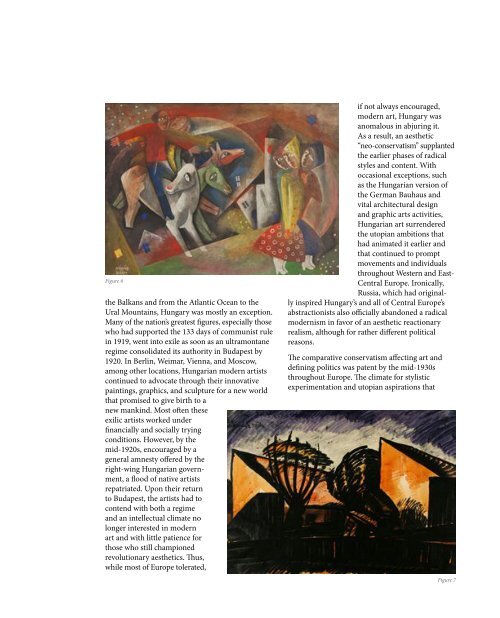The Art of Hungary
1bkCZCNNN
1bkCZCNNN
Create successful ePaper yourself
Turn your PDF publications into a flip-book with our unique Google optimized e-Paper software.
Figure 6<br />
the Balkans and from the Atlantic Ocean to the<br />
Ural Mountains, <strong>Hungary</strong> was mostly an exception.<br />
Many <strong>of</strong> the nation’s greatest figures, especially those<br />
who had supported the 133 days <strong>of</strong> communist rule<br />
in 1919, went into exile as soon as an ultramontane<br />
regime consolidated its authority in Budapest by<br />
1920. In Berlin, Weimar, Vienna, and Moscow,<br />
among other locations, Hungarian modern artists<br />
continued to advocate through their innovative<br />
paintings, graphics, and sculpture for a new world<br />
that promised to give birth to a<br />
new mankind. Most <strong>of</strong>ten these<br />
exilic artists worked under<br />
financially and socially trying<br />
conditions. However, by the<br />
mid-1920s, encouraged by a<br />
general amnesty <strong>of</strong>fered by the<br />
right-wing Hungarian government,<br />
a flood <strong>of</strong> native artists<br />
repatriated. Upon their return<br />
to Budapest, the artists had to<br />
contend with both a regime<br />
and an intellectual climate no<br />
longer interested in modern<br />
art and with little patience for<br />
those who still championed<br />
revolutionary aesthetics. Thus,<br />
while most <strong>of</strong> Europe tolerated,<br />
if not always encouraged,<br />
modern art, <strong>Hungary</strong> was<br />
anomalous in abjuring it.<br />
As a result, an aesthetic<br />
“neo-conservatism” supplanted<br />
the earlier phases <strong>of</strong> radical<br />
styles and content. With<br />
occasional exceptions, such<br />
as the Hungarian version <strong>of</strong><br />
the German Bauhaus and<br />
vital architectural design<br />
and graphic arts activities,<br />
Hungarian art surrendered<br />
the utopian ambitions that<br />
had animated it earlier and<br />
that continued to prompt<br />
movements and individuals<br />
throughout Western and East-<br />
Central Europe. Ironically,<br />
Russia, which had originally<br />
inspired <strong>Hungary</strong>’s and all <strong>of</strong> Central Europe’s<br />
abstractionists also <strong>of</strong>ficially abandoned a radical<br />
modernism in favor <strong>of</strong> an aesthetic reactionary<br />
realism, although for rather different political<br />
reasons.<br />
<strong>The</strong> comparative conservatism affecting art and<br />
defining politics was patent by the mid-1930s<br />
throughout Europe. <strong>The</strong> climate for stylistic<br />
experimentation and utopian aspirations that<br />
Figure 7


